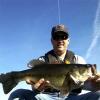It certainly is not a stupid question. I had to go away and think about it for a few hours.
There are four lines to consider:
1 - nose to tail, the designers line.
2 - the line that the lure floats.
3 - the technical line from the tow eye through the COF (center of forces) this point is a combination of the COG (center of gravity) which is the center of down forces and COB (center of buoyancy) the center of upward forces.
4 - the line that the lure actually swims, the most important line.
All the testing done in a bucket with the lure not moving forward are called static tests. BUT, once the lure is moving, water forces start to affect the float line (1). The faster the lure travels, the more effect the water forces have. These are called dynamic forces. Essentially, the dynamic line is the most efficient path through the water, possibly close to the designers line (1).
For a nose-down glider, this means that when the lure is propelled, the lure swims nicely through the water despite the ballast dragging the nose down, but as the lure speed slows, the nose starts to drop. The nose drop gives more resistance and so the lure slows faster and so on. In other words, the glide is not as long as the designer would like.
The important line is the dynamic line. as a designer, if we can make the static float the same as the dynamic, then the maximum glide would be achieved. The technical line has no real bearing on things. The only thing that matters is that the COF MUST be below this line in order to stop the lure from rolling over. In other words, keep the ballast low down as possible.
Dave



